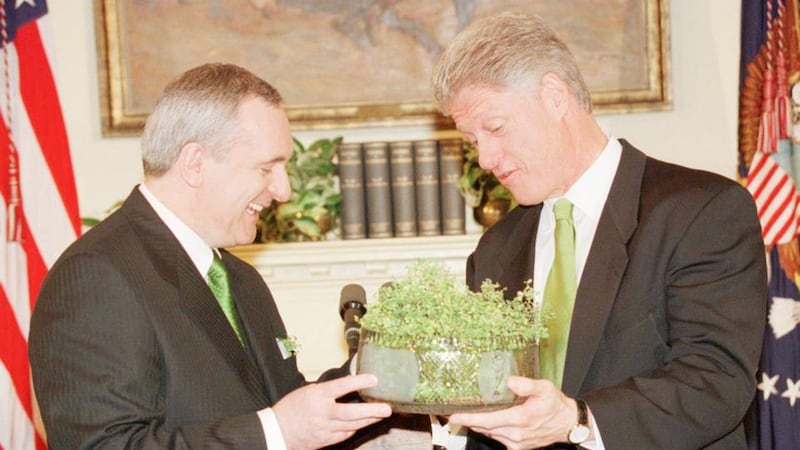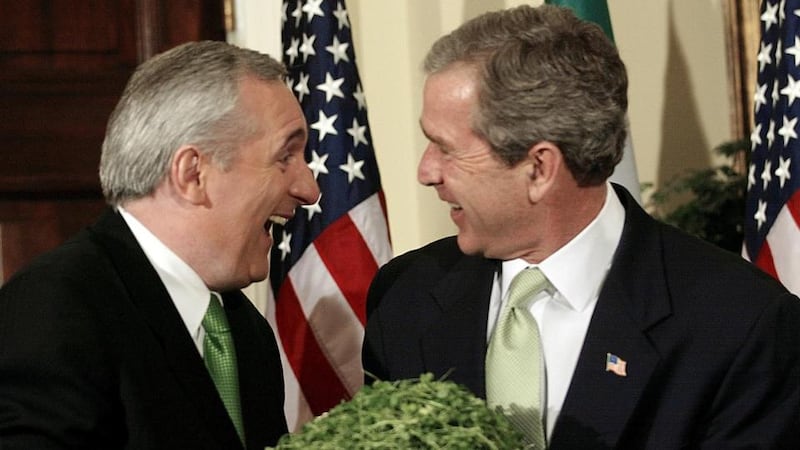While the first St Patrick's Day meeting in the White House between a US president and a taoiseach took place back in 1956, it has only become an annual fixture in more recent decades.
The practice of presenting shamrock to the US president on Ireland's national day began in modest fashion in 1952 when then Irish ambassador to Washington John Hearne sent a box of it to then US president Harry S Truman.
Before that it had been customary to present boxes of shamrock to the cabinet, senators and members of US Congress.


After the initial White House presentation in 1952, the ceremony became more elaborate the following year when the shamrock was presented, in a cut-glass bowl supplied free of charge by Waterford Glass, to newly elected president Dwight D Eisenhower.
A memo from chief of protocol at Iveagh House Thomas Horan to the secretary of the department of the taoiseach Maurice Moynihan in 1953 said the ambassador had not been instructed to make the presentation on behalf of the president of Ireland. However, Eisenhower assumed it had been so made and sent a note of acknowledgment to then president Seán T O'Kelly.
It then became an annual event and in 1956 taoiseach John A Costello, on a visit to Washington, made the presentation in person to Eisenhower.
In 1959, O’Kelly himself did the honours during an extended official visit to the US and had what was described as a very enjoyable dinner with Eisenhower.
Diplomatic event
During the 1960s the presentation reverted to a diplomatic event, with the ambassador of the day doing the needful. It was not until Ronald Reagan became president that the practice of the taoiseach going to Washington to present the bowl of shamrock and having an official meeting with the president happened again.
Reagan took an interest in Irish affairs and in the early 1980s he called in person to the residence of Irish ambassador Seán Donlon for the presentation of the shamrock.
Garret FitzGerald was subsequently invited to the White House by Reagan for a St Patrick's Day event. Charles Haughey as taoiseach also travelled to the White House but it did not immediately become an annual fixture involving the leaders of the two countries.
The Irish ambassador or occasionally a visiting minister continued to present the bowl of shamrock and there were no serious discussions with the president.
For instance, in 1992 when George Bush snr was president, minister for foreign affairs David Andrews made the presentation and the substantive talks were with US secretary of state James Baker.
Peace process
The then Irish ambassador to Washington Dermot Gallagher, who died in January, took the view that the annual slot was so unique and nationally important that Ireland should be represented by the taoiseach as a matter of course. Gallagher conveyed his view to then taoiseach Albert Reynolds who recognised the value of the event and travelled to Washington each year for the remainder of his term.
This was particularly important as Bill Clinton was then in the White House and the Irish peace process was entering its critical phase.
During Clinton’s term the Irish embassy worked with the White House to develop the St Patrick’s Day visit to include not just the shamrock presentation but a substantive meeting with the president and his team which usually lasted about 40 minutes.
Another development was the alignment of the speaker’s lunch for the taoiseach with the president’s schedule so that the taoiseach would travel with the president, with no aides, to Capitol Hill for the lunch.
Clinton also hosted a relaxed evening function in the White House which added to the sense of occasion.
Since then successive taoisigh, John Bruton, Bertie Ahern, Brian Cowen and Enda Kenny, have made the annual St Patrick's Day pilgrimage to the White House.










